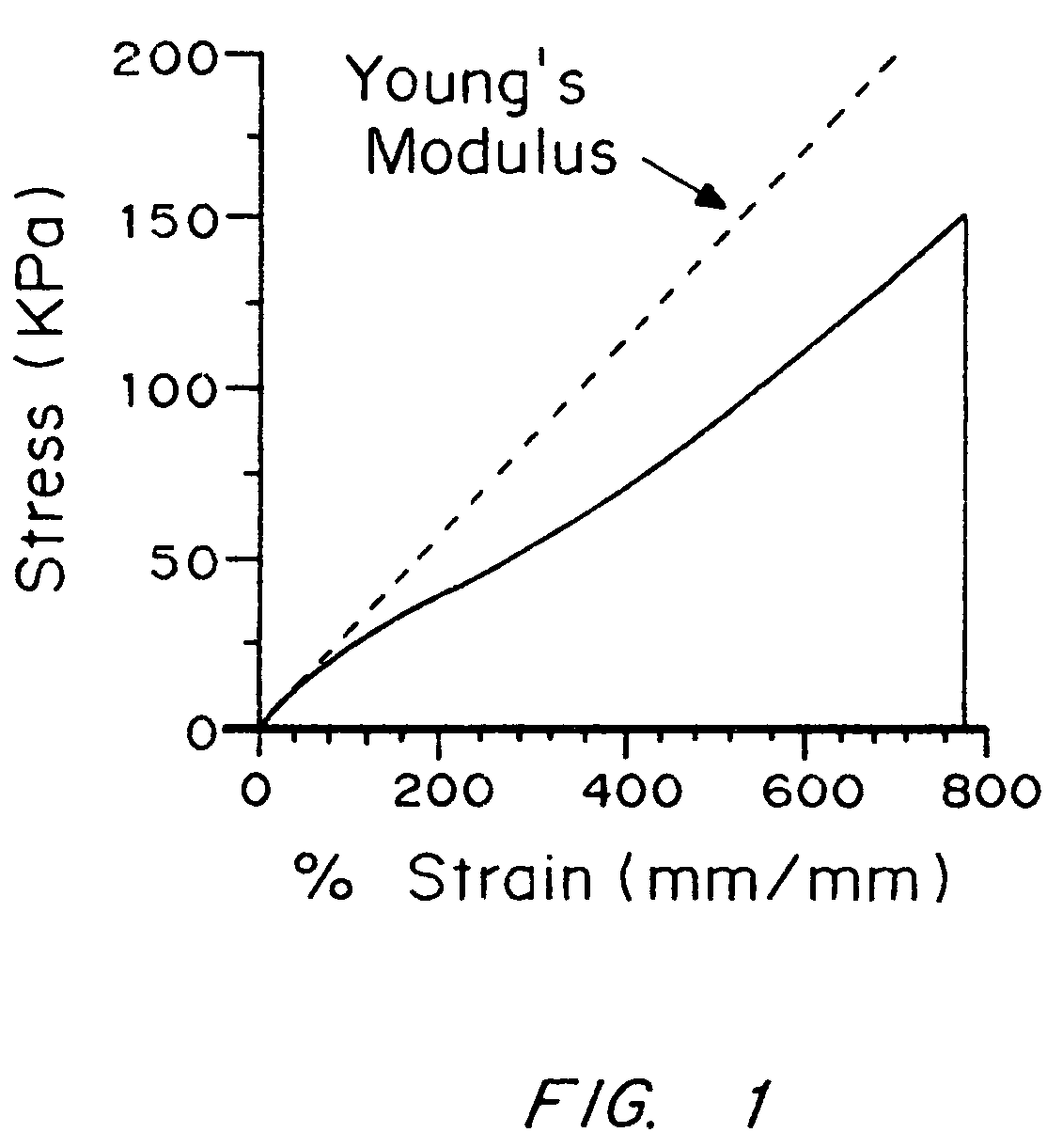Compliant tissue sealants
a tissue sealant and compliant technology, applied in the field of tissue surfaces, can solve the problems of limited adhesion, major limitation, and difficulty in adhesion of the formed gel to the tissue, and achieve the effect of improving adhesion and adhesion
- Summary
- Abstract
- Description
- Claims
- Application Information
AI Technical Summary
Benefits of technology
Problems solved by technology
Method used
Image
Examples
example 1
Relative Adhesion of Coating to Primed and Unprimed Surfaces
[0130]Fresh pig lung was primed in one area with a solution of photoinitiator (Eosin Y, 1 mg / mL (1000 ppm) in normal saline) and in another area with normal saline (prior art control). Excess fluid was removed by blotting. About 0.5 mL of monomer solution was applied to each spot. The monomer was polyethylene glycol (35,000 Daltons) terminated with caprolactone (average of 3.3 caprolactone groups per polyethylene glycol molecule) and capped with acrylic acid, essentially as described in Hubbell et al. The monomer solution contained 15% monomer (w / w), 90 mM triethanolamine, 20 ppm (w / w) Eosin Y, and 5 microliters / mL vinylpyrrolidone (v / v). The samples were irradiated with green light until cured (40 sec. at 100 mW / cm2) into a firm, transparent gel. Initial adherence was seen in both primed and control spots, although the primed spots had better overall adherence.
[0131]The lung was connected to a pressure-controlled inflation...
example 2
Sealing of Wedge Resection of Lung
[0132]In lung operations, it is common to make a “wedge resection” to remove diseased areas. A combination stapler / cutter is used to simultaneously cut and staple along one side of the wedge to be removed, and is then used to staple and cut the other side so that a wedge-shaped piece of lung is removed, while the remaining lung is simultaneously stapled closed. Despite a high staple density, the staple lines are prone to leak air, which can produce severe complications in a patient undergoing such an operation.
[0133]Frozen-thawed pig lungs were wedge-resectioned, using a ProxiMate™ TLC 55 reloadable linear cutter / stapler (Ethicon; Somerville, N.J.). Every second staple was omitted from the outer staple lines in the cassette to reliably induce leaks. Lungs were inflated with air to a pressure of 40 cm H2O, and leaks were observed by pushing the stapled area just under the surface of a water bath (similar to leak testing of an inner tube). Next, stapl...
example 3
Lap / Shear Strength of Primed and Unprimed Bonds
[0136]Adhesion under shear of gel to rat skin was determined on an Instron™ apparatus using standard methods. The biological surface was rat back skin, freshly removed from euthanized animals. It was glued to a glass slide, and treated as described below. A casting chamber was positioned above the skin, which also contained a gauze mesh which protruded from the chamber. Monomer solution was injected into the chamber and polymerized. The chamber was removed, and the tensile strength of the bond was determined by shearing the lap between the glass slide and the gauze mesh in a standard load cell on the Instron™.
[0137]Skin treatments included none (control); primed; primed and pre-coated with monomer solution by drip; and primed, pre-coated with monomer solution by drip, and rubbed or mixed with a brush. A monomer solution as in Example 1 was applied, except that the monomer, “8KL5”, had a smaller PEG molecule (8000 D), and was extended wi...
PUM
| Property | Measurement | Unit |
|---|---|---|
| thicknesses | aaaaa | aaaaa |
| thickness | aaaaa | aaaaa |
| physiological temperatures | aaaaa | aaaaa |
Abstract
Description
Claims
Application Information
 Login to View More
Login to View More - R&D
- Intellectual Property
- Life Sciences
- Materials
- Tech Scout
- Unparalleled Data Quality
- Higher Quality Content
- 60% Fewer Hallucinations
Browse by: Latest US Patents, China's latest patents, Technical Efficacy Thesaurus, Application Domain, Technology Topic, Popular Technical Reports.
© 2025 PatSnap. All rights reserved.Legal|Privacy policy|Modern Slavery Act Transparency Statement|Sitemap|About US| Contact US: help@patsnap.com


